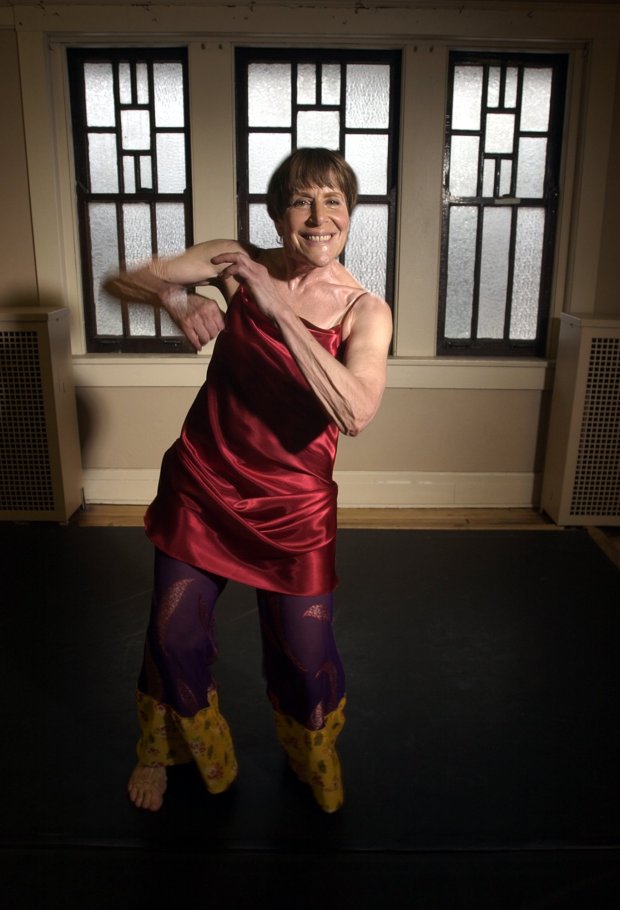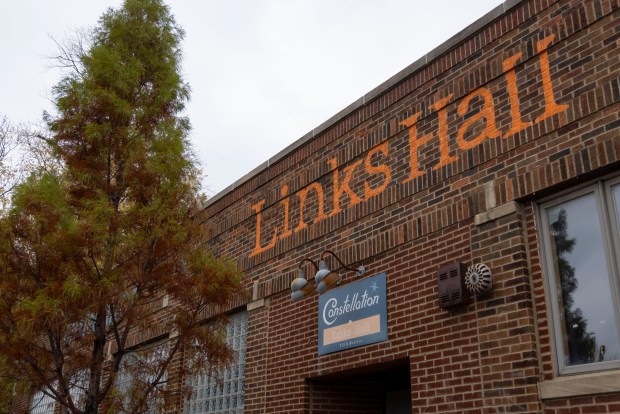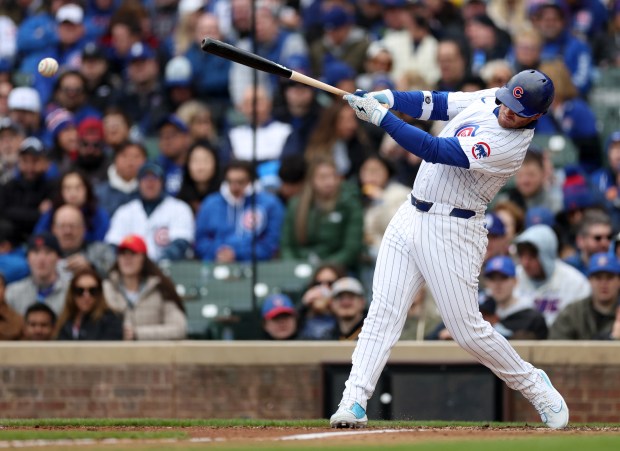As with theater, Chicago’s dance institutions have faced practical and existential questions in the two years since the recovery from the pandemic began in earnest. Emergency pandemic-era funding has dried up, attendance is still down and philanthropy is changing — just as institutions face increased pressure to provide conventional work conditions (like a living wage and benefits) for what has historically been deemed unconventional work.
The confluence of those challenges has particularly stressed small and mid-size organizations. Some seize the moment as a sign of the end of an organization’s natural life cycle. Soham Dance Space closed in September. A few weeks ago, the Chicago Moving Company moved out of its long-time home at Hamlin Park Fieldhouse and will wind down after more than five decades.
Others, like Links Hall, push on. The 46-year-old dance and performance art venue known for pushing the envelope launched a campaign called “Lifeline for Links” last week.
“We’re in this very transformative moment,” said executive director SK Kerastas. “We’re trying to move through this moment with a lot of transparency and calling in our community.”
Crowdfunding a goal of $350,000 in two months is not just a band-aid bandage, Kerastas said. A collective of artists, staff, board members and other stakeholders have joined forces to forge a forward-thinking plan for Links Hall’s future.
“That amount will stabilize the organization and give us a launch pad of resources to move strongly into our next iteration,” Kerastas said. “One of the reasons Links has stayed alive for this long is because of its ability to adapt, innovate and change. If we are going to continue to breathe life into the performance culture of Chicago, we have to face these conditions with innovative thinking and a willingness to change.”
In 1978, Carol Bobrow, Bob Eisen and Charlie Vernon rented an empty room at the cross-streets of Clark, Newport and Sheffield. They called it Links Hall, after the inscription on the building’s edifice. The story of Links Hall is a common one: a group of scrappy optimists pooled their resources to make a place for their art. The uncommon part is that it worked.
Links Hall became a hotbed for experimentation and collaboration. Through the ‘80s and ‘90s, it was the epicenter of Chicago’s contact improvisation scene, a launch pad for countless artists to present their first dance concerts and home to storied platforms like the LinkUP artist residency and Poonie’s Cabaret. For many aspiring dancers and choreographers, Links Hall is hallowed grounds — a rite of passage.
To be clear, that room above a Wrigleyville bar was not glamorous. The floors and windows rumbled from Red Line trains passing by and Cubs fans imbibing below. The audience experience typically included an uncomfortable folding chair and a coin toss as to whether the plumbing would cooperate. But those white walls and gleaming maple floors became so synonymous with Chicago’s experimental dance scene that Links Hall replicated them when they moved to Roscoe Village in 2013, partnering with music venue Constellation to renovate the former Viaduct Theater.
By then, Links Hall had long been a nonprofit institution with a growth model, validated as not just a local arts incubator but also a desired spot for touring artists and festivals. A big shift came in 2019 after a grand 40th-anniversary fundraiser and celebration, followed shortly after by a complete staff turnover.
“The main takeaway the board left with was around burnout and doing too much,” Kerastas said. “They made a commitment not to replicate that. They made the choice to increase residency artist stipends, they increased salaries, they implemented travel stipends for artists on the South and West sides and created a couple part-time roles.”
Kerastas is the second executive director since then, succeeding Stephanie Pacheco, who now leads The Yard on Martha’s Vineyard. Kerastas marks a full year in the role at the end of the month and points to several “intense funding blows” since coming on board. A few key grants did not materialize, creating an unsustainable cash crunch that forced the organization to accelerate a strategic two-year campaign aimed at raising $750,000 to refill the coffers, maintain an increased budget instituted during the pandemic and bridge the gap caused by shaky grant funding.
“That campaign has been doing really well,” said Kerastas, whose previous roles include producing for California Shakespeare Theater and Berkeley Repertory Theatre, following four years as education director for About Face Theatre. “We have 41.5% of our first-year goal committed. Along with those successes have come these blows and we felt like we’ve been cut off at the knees.”
One position was eliminated. Scaling back the organization’s pay equity commitment, however, which significantly raised the annual budget, is not on the table. And the venue itself is buzzing, with events like the annual Bridge Dance Festival (an ongoing initiative that started with a Links incubator grant), a self-produced show by dancer/choreographer and dance therapist Kate O’Hanlon Bruns based on the Myers-Briggs personality test, Minneapolis-based Ananya Dance Theatre and the 34th annual Sunrise Solstice Concert — considered together, a prime example of what Links Hall is and has always been.
“Some of the exciting things that are happening around this is the Links community is activated in a way that it hasn’t been in years,” Kerastas said. “There isn’t another small arts organization like it that’s still here.”

Nana Shineflug, 67, dances in the Chicago Moving Company’s rehearsal space at Hamlin Park in Chicago in March 2003. Shineflug founded the company in 1973. (Stacey Wescott / Chicago Tribune)
Nearby, another legacy dance institution has opted to close. Founded in 1972 by Nana Shineflug, Chicago Moving Company exits stage left at the end of the year.
“It’s not an easy decision,” said Kay LaSota, once a co-manager at Links Hall and long-time manager/producer for CMC. “I do think things have a life cycle and an arc. To extend beyond that when it doesn’t seem to be happening naturally doesn’t make a lot of sense.”
The decision to close was not financial. She admits the funding landscape is tough — perhaps not unusually so.
“There’s the fantasy of the ‘better time,’” she said. “The better time was in the past, or the better time is to come. I’ve been doing this for 40 years. There is no better time. It’s cyclical. It is always a hustle and a struggle. It’s never not been that.”
LaSota said the performing arts are moving beyond the “founder” model. Companies based almost solely around a single choreographer’s vision aren’t as viable as they once were. There was also the matter of who would take it on next. Shineflug died in 2015; a transition plan has been a looming question since far before that. Throughout and beyond the pandemic, LaSota turned her attention to the company’s archives, which have been given over to the Newberry Library’s dance collection. The studio theater at Hamlin Park — a darker, equally hallowed version of Links Hall — was one of the few performance spaces start-up artists can still afford. Chicago Moving Company was one of the first crop of arts partners with the Chicago Park District in 1995. It took 13 years to get theater rentals approved. A few weeks ago, LaSota took everything down.
“People had the best days of their lives there,” LaSota said. “It’s hard to lose that — and it’s also a resource. Moving Company had really tried to be that. I think we were in a lot of ways.”
Indeed, CMC had moved beyond Shineflug’s singular voice, culling innovative platforms including The Other Dance Festival and Dance Shelter, carving a dance home for Ayako Kato and Rachel Bunting, both former company members who’ve rehearsed there for over a decade. And the Hamlin Park Theater, though bare bones, has hosted several productions among this critic’s all-time favorites: Khecari’s 2012 “The Clinking,” Emma Draves’ 2018 “Listen,” and Re|Dance’s recent “A Delicate Hand,” to name a few.
To lose such a space is a blow to the DIY dance scene. On that, LaSota is a pragmatist. She’s also an optimist.
“Presenting might be at a lower level for a while until some other thing comes up,” she said. “My first job when I came to Chicago was at MoMing. It was kind of like Hamlin. It was even better. It was the place. And then, for various reasons, it also died. Then there was a vacuum and other things rose up in response, with people thinking about what they needed and wanted — and then doing it.”
Lauren Warnecke is a freelance critic.




